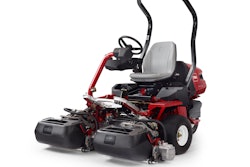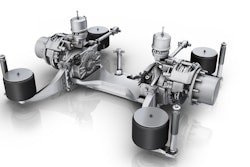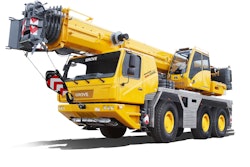Guided by the principle of zero emissions, ZF strives to achieve the ambitious claim of enabling compact work machinery such as compact loaders to also drive emissions-free in the future. Technology leader ZF is setting new standards for electrical drives, especially when it comes to integrated system solutions.
In urban environments in particular, the market for work machinery demands agile handling and optimum mobility. ZF set itself the goal of developing compact electrical vehicles that could also meet the performance of conventional vehicles.
With only a 48V operating voltage, the application falls under the Low Voltage Directive. This offers enormous benefits in terms of safety components and vehicle maintenance. Servicing costs are therefore kept to a minimum.
In-house expertise
Extensive experience with electric lift trucks and close collaboration with the e-mobility division has allowed the work machinery systems team to benefit from ZF’s own expertise in the field of electrification. Many development insights from automotive and material handling can also be transferred to off-highway applications.
The ZF driveline for electric compact loaders uses an e-engine (i.e. electric motor) transmission which has been developed especially for this application using actual measurement data from conventional compact loaders. This allows for greater levels of cycle efficiency and avoids the need for load reduction (derating) of the components. To guarantee a steady performance, unlike its competitors’ products, ZF opts for a liquid cooling medium. The use of liquid cooling in the engine and the power electronics also ensures consistent and lasting performance in construction machinery applications. An e-engine and hydraulic pump make up the electric hydraulics system.
ZF the pioneer
ZF has found a ‘best in class solution’ for power density. The solution is unrivalled on the market in the 20 kW (continuous performance) and 48V performance classes. For outputs ranging between 20kW and 40kW, a modular e-motor has been specified for the drive. High levels of system efficiency are guaranteed, and the drivetrain can be combined with standard ZF axles for compact loaders. It has been designed to extend the continuous performance to 40 kW – and with an operating voltage of 600V. The eCWL project for electric compact wheel loaders aims at developing a system solution for machines with an unladen weight of up to 8 t.
To make the most of the special properties of e-engines, the development team has chosen a new, high-speed transmission to complement the ZF modular kit. Vehicle typologies generally remain the same, as conventional and alternative drivetrains can become a reality on a single platform. That makes it possible to keep the entire system's costs and complexity to a minimum.
Emission-free and eco-friendly
The ideal location for compact electric vehicle applications – The urban construction site of the future.
Quiet and pollution-free operation helps to make construction work in inner-city areas or buildings a reality, despite strict emission controls. It also shows potential for agricultural applications in terms of environmental conservation or animal protection, such as use in stables.
In addition to providing emission-free applications, electrification also enables improved vehicle networking and control.
The non-automotive sector is calling for even more autonomous, networked and flexible vehicle concepts - caused by macro trends like urbanization, digitalization and the switch to renewable energy. Tightening up of legislation through stricter emissions directives means it is vital to develop such solutions.
More applications to come
With the electric compact loader, ZF is taking its first step on the road to emission-free construction sites. In the long-run, the technology can also be adapted for other construction machinery applications. Increased energy density, continuous price reductions and lower energy production costs thanks to renewable power sources will see batteries become the main energy source for more and more applications.



















